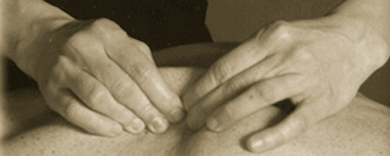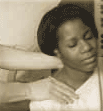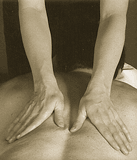|
Barbara Bohaty understands the science of relaxation. As a massage therapist, she soothes her clients’ aches and promotes healing. Knotted muscles relax beneath her hands, pain subsides, and stress dissipates. “This is a job where you can really help people,” says Barbara. “People come in with pain, you work with them, and they leave feeling better.”
Massage therapists work to improve the circulation of blood through the body and to speed the removal of metabolic waste products from muscles. Their skilled kneading increases the flexibility of muscles, ligaments, and other soft tissues.

Some people visit Barbara to relieve a specific pain or to warm up before a sporting event. Others want to relax and reduce stress. Barbara starts every session with an intake interview to discover what the client needs. “I ask clients questions to find out why they’ve come,” she says, “what goals they want to achieve.” Identifying the client’s goals helps her plan the massage.
Barbara also asks clients about their medical condition. Some types of massage exacerbate certain illnesses and injuries. “If a client has diabetes, a sprained ankle, or any other conditions, I need to know before I start.”
After the intake interview, Barbara usually begins with a calming massage. She has the client lie on a massage table, one of the standard tools of her trade. Standing beside the table, she uses relaxing strokes on the client’s muscles, varying the pressure as she works. If she feels tension and knots beneath the skin, she spends more time on those areas.
As the massage progresses, Barbara changes her technique to attack any problems she finds. She might try rhythmic drumming strokes, apply light or heavy pressure, or hold part of a muscle until it relaxes.
Some clients have specific goals that require a specific approach. This is true for the athletes among Barbara’s clients. “If I’m massaging an athlete before an event, I want to loosen and warm up the muscles,” she says. “After an event, I want to help the body recover and cool down. I gently rub and squeeze the muscles to get out the waste products that build up during exercise.” She also massages painful or overworked areas to stave off injury.
Barbara uses her knowledge of anatomy to locate the sources of her clients’ discomfort. “Muscles are interrelated. Pain in one part of the body can be caused by problems in other parts,” she says. As she works, Barbara might teach her clients about the causes of pain and explain how to remedy them with ice, heat, stretching, or exercise.
Many clients are referred to massage therapists by physicians. One of Barbara’s clients is recovering from knee replacement surgery. Careful massage is helping to lessen the client’s pain and improve her range of motion.
Massage therapy is a physically demanding profession. Along with extended periods of standing, massage technique requires therapists to use some of their muscles repeatedly. This repetitive motion causes problems over time. “Massage therapists develop injuries to their wrists and hands if they aren’t careful,” says Barbara. “The body breaks down under the strain.”
To reduce her risk of injury, Barbara uses proper body mechanics during every massage. She adjusts the table to a comfortable height, keeps her wrists at a safe angle, and uses the strength in her arms and torso to support her wrists and hands. She also limits the number of hours she works to 5 a day, schedules rest periods between massages, and exercises often. In a temporary role reversal, Barbara receives a long massage at least once a week—one of the most pleasant parts of her self-care regimen.
In addition to a table, massage therapists need other basic equipment: sheets, blankets, neck pillows, and creams to reduce friction on the skin. Therapists practice in health clubs, resorts, chiropractic offices, their homes, or any other convenient place. Most days, Barbara works in a massage office near her home in Ceresco, Nebraska.
But she also practices in more adventuresome locations. Every summer, she spends a month bicycling across the United States, a 25-pound folding massage table in tow. By day, she rides. In the evening, she massages fellow riders in tents positioned along the route. Closer to home, Barbara takes her table to local running and biking marathons.
 Like many massage therapists, Barbara sometimes abandons the table and gives seated massages. Clients sit on a portable massage chair while she rubs their necks, backs, and shoulders. These massages are shorter than standard massages, which last between 30 to 90 minutes. Seated massages usually last 15 to 20 minutes and can take place almost anywhere, including office buildings, shopping malls, and community events. Because seated sessions are brief, a therapist might see as many as 10 clients in a day. Like many massage therapists, Barbara sometimes abandons the table and gives seated massages. Clients sit on a portable massage chair while she rubs their necks, backs, and shoulders. These massages are shorter than standard massages, which last between 30 to 90 minutes. Seated massages usually last 15 to 20 minutes and can take place almost anywhere, including office buildings, shopping malls, and community events. Because seated sessions are brief, a therapist might see as many as 10 clients in a day.
Barbara communicates with her clients as she works. She observes clients’ physical reactions and encourages their comments. “Massage therapists need to be good listeners,” she says. They need good interpersonal skills because they have to inspire trust.
Massage therapists also need specialized training. After earning a high school diploma, they attend massage therapy school. There, they learn anatomy and physiology (the study of the structure and function of organs and tissues) and kinesiology (the study of human motion and body mechanics). Students also learn several massage techniques and receive hands-on training.
Barbara was a physical education teacher before attending massage therapy school. She began giving massages as an amateur. During summer bike trips, she and fellow cyclists massaged each other’s sore muscles. She discovered the benefits of massage and learned she had a talent for it.
She enrolled in a 9-month massage therapy program at a school in Omaha, Nebraska. Attending classes at night, Barbara continued to teach physical education during the day. After graduating, she started a part-time massage therapy business. Three years ago, she decided to make massage therapy a full-time career.
Barbara continues to take massage classes and teaches at a nearby massage therapy school.
There are between 120,000 and 150,000 massage therapists in the United States, according to the American Massage Therapy Association. Almost half work part time. Those who work at least 6 hours a week have median annual earnings between $20,000 and $29,000 and charge an average of $48 an hour.
Many massage therapists are self-employed. They pay for their own equipment, continuing education, and liability and health insurance. They may pay other expenses as well, such as transportation and office rental.
 Twenty-nine States and the District of Columbia require massage therapists to be licensed. Most of these States require at least 500 hours of classroom instruction at an accredited school. Many States, including Barbara’s, require 1,000 hours of classroom training. Some States require massage therapists to pass a national certification exam. Most local governments have additional regulations governing massage. The American Massage Therapy Association, the Massage and Bodywork Association, and local chambers of commerce can provide current information on licensing. Twenty-nine States and the District of Columbia require massage therapists to be licensed. Most of these States require at least 500 hours of classroom instruction at an accredited school. Many States, including Barbara’s, require 1,000 hours of classroom training. Some States require massage therapists to pass a national certification exam. Most local governments have additional regulations governing massage. The American Massage Therapy Association, the Massage and Bodywork Association, and local chambers of commerce can provide current information on licensing.
After 10 years, Barbara continues to enjoy her job. “Massage therapy lets me do so many of the things I like,” she says. “Making people happy is satisfying work.”
Photos courtesy of the American Massage Therapy Association
 Top Top
|



